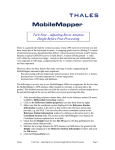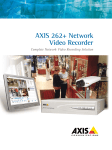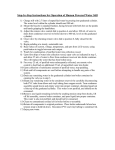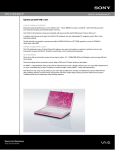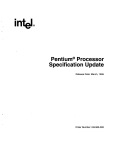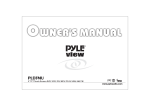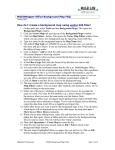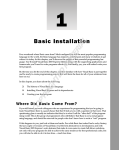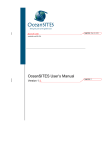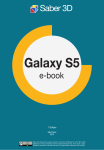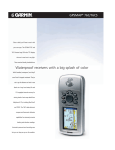Download Product Review
Transcript
ProductReview By Al Pepling, LS Al Pepling works for Trans Associates in Pittsburgh. He is licensed as a professional land surveyor in Pennsylvania, as a professional planner in New Jersey, and is a past president of the New Jersey Society of Professional Land Surveyors (NJSPLS). MobileMapper by Thales Navigation n the tradition of the Locus and and mapping consumers. Mobilethe ProMark2 from Thales Mapper comes with MobileMapper Navigation, (formerly Ashtech), Office and MobileMapper Transfer softthe MobileMapper is primarily ware to give the purchaser a complete intended to be used for GIS solution. The trial box that I received data capture, and it has great included data transfer cables as well as navigation features as well. The addition- batteries. al capability of receiving the Wide Area MobileMapper will track up to 12 Augmentation System (WAAS) correcsatellites with its 12 parallel-channel techtors make the MobileMapper more than nology. It has a quadrifilar antenna, capable for doing GIS work. which I will leave up to the electronic To some practitioners, the mention of engineers to explain, but like a total staGIS evokes disparaging comments. If tion or GPS, I do not need to know how yours are among them, please read a litto design one to learn to use it effectivetle further. Land surveyors have been ly. It does do the job. In daily use it doing GIS data capture will begin tracking satellites in and cartography since approximately 15 seconds and the inception of land updates the screen every secsurveying. Don’t forond. Off the shelf it takes get that in the early about a minute or so to get days of this country, acclimated to its position surveyors also acted and begin tracking as title people, realSVs. From the tors, and more. They time I powered collected the land feathis unit up, tures and made maps after installing for governments and the batteries, it individuals. Today, took less than technology allows minute out in us to collect more the open information than with a good ever before, clear view of which is used by the southa greater number of people than ever before. As the expert measurers, our role is crucial to the integrity of the data and the ease with which it is Figure 1 used. We need to get MobileMapper more involved in all areas from Thales of GIS. Think about it! Navigation MobileMapper is a relatively inexpenFigure 2 External sive GPS tool that allows us to expand antenna port our areas of service to data collection I ern sky. The view to the southern sky is necessary for the WAAS signals, but more on that later. MobileMapper is 6.5 inches long, 2.9 inches at its widest point, about 1.2 inches thick, and fits easily in your hand. It weighs about 8 ounces with two “AA” batteries aboard. The 2.2-inch x 1.75inch high contrast color LCD display is backlit and can be seen under bright sunlight. The case houses the manual and is made of a plastic material a matte finish in blue and black that cuts down on the glare on a bright sunny day. While this may seem like a minor detail, a few seconds of glare here and there is one thing, but eight to ten hours of repeated glare is quite intolerable. (Figure 1) Features and Accessories Page 113 of the manual states the housing is “IEC-529 IPX7 Standard” and explains that it will withstand water immersion for more than 30 minutes at a depth of one meter. I did not try to verify this, nor did I take the unit apart to explore its water resistant components. The black band around the periphery of the unit is called “wraparound rubber armor” and is softer or more pliable than the blue-colored portions of the housing. This band has perpendicular “ribs” wide- Displayed with permission • The American Surveyor • March-April • Copyright 2004 Cheves Media • www.TheAmericanSurveyor.com ly spaced around it, making it comfortable to hold and operate and secure in your hands. A small rubber flap on the right side of the unit serves as the cover for the external antenna connection (Figure 2). Using an external antenna properly will increase the accuracy of the Mobile-Mapper. Most of the features you collect will be in urban areas that have more obstructions to the satellites. Two contributors to accuracy degradation are lack of open sky to the south and the physical blocking of satellite signals with your body when using the unit without an external antenna. A third is “multipath”, which is a reflected signal that arrives at your processor milliseconds after the original signal. These extraneous signals have no corresponding signal for the same epoch from the other satellites being tracked and they contribute to degra- Figure 3 Rear of unit, showing data transfer port, battery compartment, and memory card dation of your collected position. For convenience you could mount an external antenna on a hat (using Velcro) and stand directly over the feature to be collected, leaving both hands free for unit operation. Another would be to mount the external antenna on a two-meter prism pole, use some sort of unit-to-pole mounting bracket, and operate the unit similarly to those of RTK operations today. Either method coupled with care in selecting your data collection positions will help to reduce your positional error. Thales also provides an external antenna with a 12-foot cord as an accessory for the MobileMapper. Other accessories include a PC data cable, an external power cable with cigarette lighter adapter, a power data cable, and a PC cable with cigarette lighter adapter. Since most newer laptop computers and other portables no longer include serial ports as standard, there are also a serial-toUSB adapter cable accessory, 32MB and 64MB secure digital memory cards, and a canvas carrying case. Accessory mounting brackets include a swivel mounting bracket, a vehicle mounting bracket, and a bicycle mounting bracket. Removing the batteries allows you to access the memory card (Figure 3). The battery compartment cover has two sliding buttons that open and/or lock the cover in place, which helps to protect the card from dust, dirt, and precipitation. They work very well. The reaction of some is that a separate external slot ...a marked difference. Deadlines On a tight deadline? Large or small, simple or intricate, one to 1,000...Berntsen can supply you with the markers you need for every job that comes your way. From the daily projects that require your name and LS number to the special projects that require one custom monument with intricate artwork. Berntsen has over 30 years experience assisting you in reaching your deadlines. Berntsen quality ...a marked difference. 877-265-2304 www.berntsen.com Berntsen International, Inc. • PO Box 8670 • Madison, WI 53708-8670 • Toll-free: 877-265-2304 • Fax: 800-249-9794 • Email: [email protected] Displayed with permission • The American Surveyor • March-April • Copyright 2004 Cheves Media • www.TheAmericanSurveyor.com would be a better arrangement. I would not agree! The external secure digital slot on my iPAQ is always facing up when I carry it outside of the environmental case in my shirt pocket. Dust, dirt and rain have unimpeded access. Cleaning the card and blowing dust out of the slot has become almost a routine. The Thales solution affords better protection for the card and the data. Positional Accuracy The MobileMapper will operate from 14° to 140°F. In warmer months with average temperatures, the two AA Lithium-Ion batteries give approximately eight hours of battery life with backlight and some 16 hours of battery life when the backlight is not used. Battery life is less when operated in the colder climates and seasons. External power sources from 9 to 35 volts DC can be used to extend battery life. When the unit is not WAAS-enabled, positional accuracy at 95% 2D RMS is specified at 7 meters; WAAS-enabled, it is less than 3 meters. These accuracies are subject to the amount of time on the point. My opinion is that less than 2.5meter accuracy can be achieved with longer feature occupation times in 2D positions. I have approached that kind of accuracy with a non-WAAS unit right after Selective Availability (SA) was turned off in May of 2000. This is where the surveyor’s expertise comes into play. Transmitted along with the collected features can be a statement that this group of features was collected to a positional accuracy of x.xx meters. It is this expertise that separates the experienced land surveyor from the less informed GIS data collector technician. (As an example, while in the employ of another firm, our GPS survey group was called in to advise a mapping group of a branch office on how to improve their GPS collected data for a county GIS client. The county had checked some of the mapping data with its own mapping grade GPS and reported several differences. Much of the data, on a project already over budget, had to be recollected to meet the client’s contract specifications.) Just above the battery compartment are four contacts and a threaded brass insert with which to connect a data transfer cable for uploading or downloading data (Figure 4). The cable can also be connected the unit when it is in a cradle. The exposed pads on the back of the unit and the exposed “spring tabs” on the cable are easy to clean. Cleanliness is crucial for low voltage digital data transfer. Eight push buttons and one scrolling button Figure 4 Data transfer cable Displayed with permission • The American Surveyor • March-April • Copyright 2004 Cheves Media • www.TheAmericanSurveyor.com selected for your area and jobs. When you open a job, an alphanumeric screen is displayed. You use the scrolling button to move the cursor, a red highlighted square, to the desired letter and press ENTER to accept it. Spell out the job name and then scroll down to the OK area and press ENTER to accept it. It sounds laborious but goes rather quickly as you become more adept at it. As I typed this review, I placed the MobileMapper on my northeast-facing windowsill just to see if I could even track one SV. I was seeing perhaps 20% of the sky. It tracked five SVs and gave a PDOP as low as 7. Going outside and facing about 50% of the southwestern sky gave me eight SVs and a PDOP of 3. It’s the quadrifilar antenna that does it! I never have seen a windowsill feature in any GIS data I have looked at, so I did not save it. Figure 5 shows a sky plot, with nine satellites being tracked. The feature collection screen displays the amount of time you are on the point Figure 5 Sky plot showing nine satellites being tracked control the operation of the unit. The soft rubber keys are reminiscent of the HP48 keyboard and easy to get used to. Press the red PWR (power) key, wait for some informational screens, and press the ENTER key to accept the warning screen (this is the equivalent of accepting End-User Licensing Agreements, or EULAs). Pressing the ENTER key also turns off the unit (a five-second power down message will appear that can be interrupted by pressing the ESC[ape] key to continue operation). Holding the PWR button down for two seconds also turns on the backlight. Tapping the red PWR button twice in quick succession also turns the unit off. The IN and OUT keys are used to zoom in and out on the maps displayed on the screen. ESC returns you to the previous screen without making any changes. NAV takes you to the various navigation and waypoint screens. LOG does a few more things; this is where you create new jobs or open existing ones. If you are in a job, it will take you to the feature attribute screen. When you are already in a job, but have no open feature, LOG will take you to the feature selection screen. MENU does just what it is named to do. ENTER is how you accept your highlighted input or initiate various unit functions. There is some setup to go through when you first power up and use the MobileMapper. Language, coordinate system, map datum, and units need to be Displayed with permission • The American Surveyor • March-April • Copyright 2004 Cheves Media • www.TheAmericanSurveyor.com if you stand still over it. The following is a list of the screens/menus: Menu, Setup Menu, Region, Area, Time, Date, Units, Map Datum, Coordinates, Language, Library, “Welcome”, Job Name, Attribute Value, Description, Point Offset, and Grid Setup, to name some of them. In the navigation mode, there are more screens such as: Alarms, Speedometer, Sat Status, Data, Map, Road, Compass, Position and Large Data. Yes, there is a lot of software onboard this GIS data collector! Data can be downloaded to a PC or uploaded from a PC using MobileMapper Office via MobileMapper Transfer. Downloading is a two-step process. First you must convert the raw file to a GIS readable format (SHP, MIF, or even DXF). Next click on File, then click on Export. Uploading is similar in that your SHP, DXF, or MIF files are converted into the *.mmj file format used by the MobileMapper, just like the *.raw and *.crd files we have been uploading and downloading between our guns and office software for years, but with different file formats and extensions. The handy 24-page Getting Started Guide, gives users a rudimentary explanation of what GIS data collection is and how to go about it, while the 120-page User Manual goes into greater detail. MobileMapper Office is the office complement to the MobileMapper data collector unit. It is deserving of its own review. Some of the newer software for surveyors can also handle GIS data and mapping. All GIS databases need to be maintained, and many need to be updated. Many would benefit from the data collection knowledge of practicing land surveyors. The Thales MobileMapper makes it possible for surveyors to expand their services and client bases at a minimal cost with this comparatively inexpensive handheld GPS tool. With MobileMapper, you’ll be hard pressed to use the “I’ll just wait until I can afford GPS” excuse. Try one out for yourself and form your own opinion. ALLEN PRECISION EQUIPMENT Used and Demonstration Equipment Specials 1.800.241-6223 • www.allenprecision.com Displayed with permission • The American Surveyor • March-April • Copyright 2004 Cheves Media • www.TheAmericanSurveyor.com





